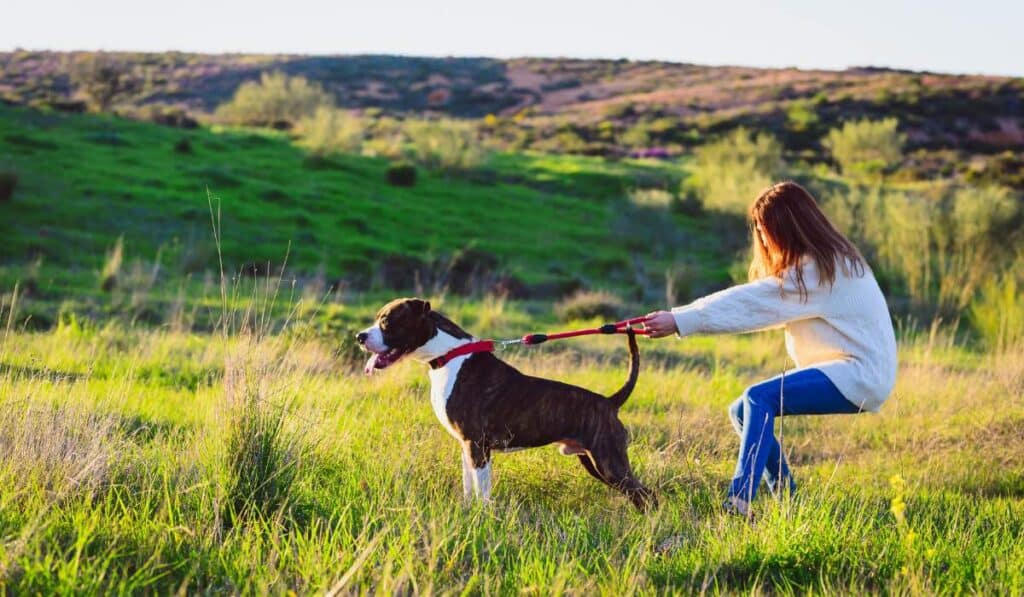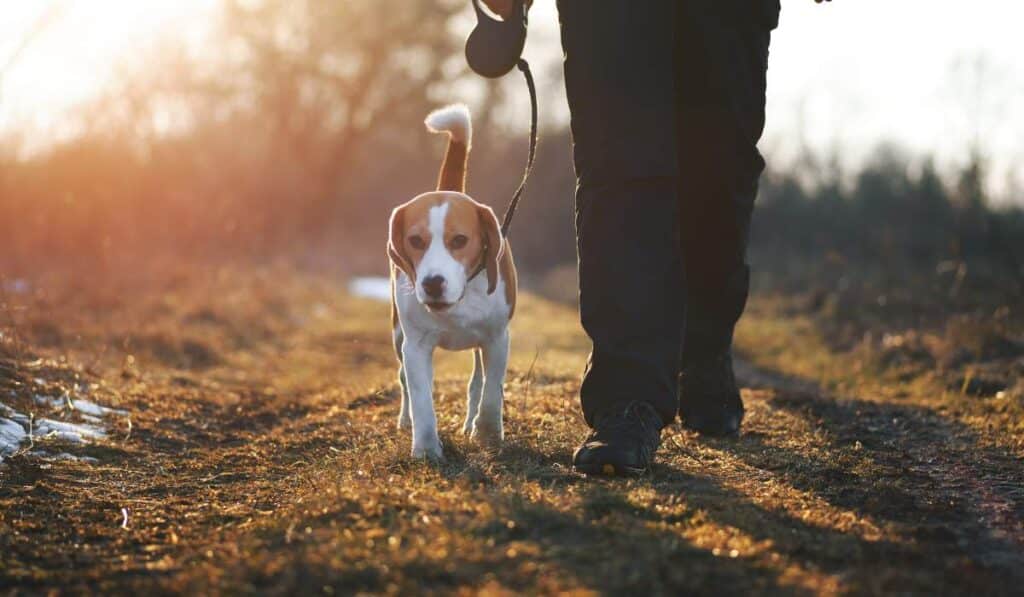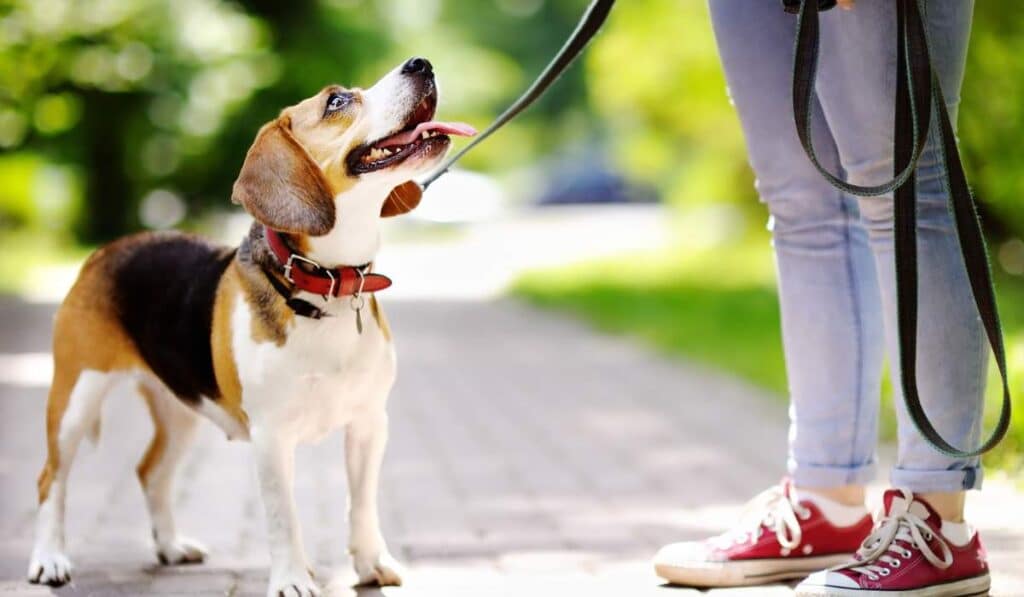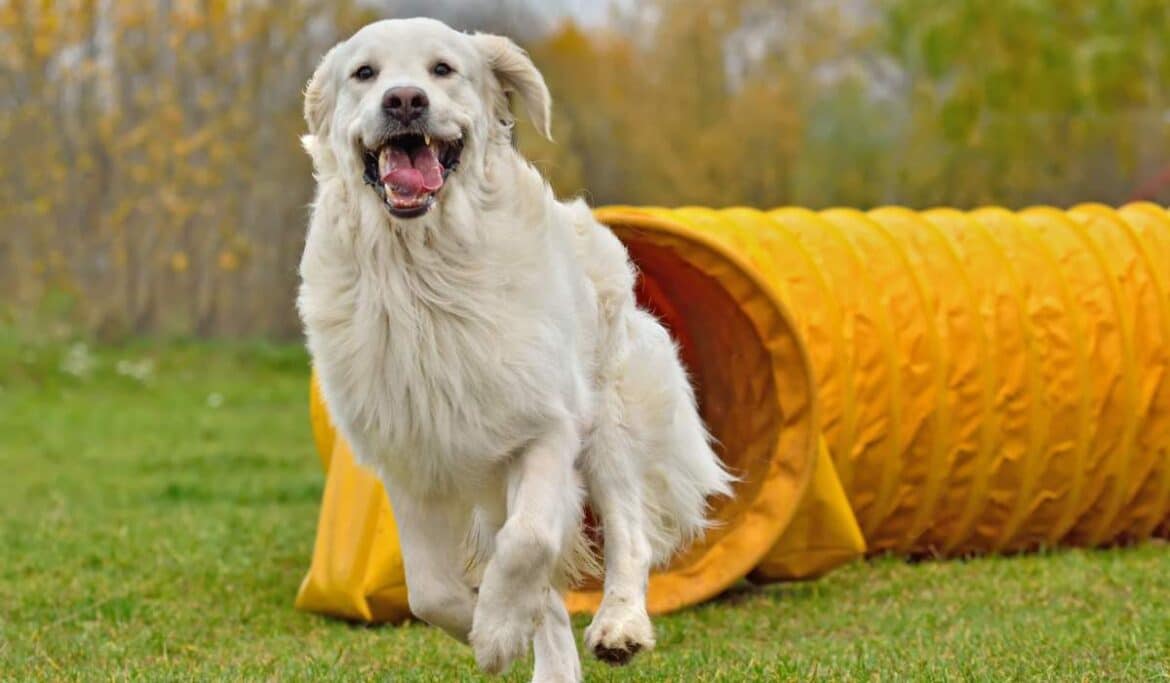Are you tired of your dog pulling on the leash during walks? Do you dread taking your pup out because they drag you down the road, stopping at every tree and sniffing at every pace? If so, it may be time to consider loose-leash walking training.
Loose leash Training is a structured way of teaching your dog to walk politely on a leash without pulling or tugging. By using positive reinforcement techniques and consistency, dogs can learn to enjoy their walks while staying by their owner's side.
There are numerous benefits to teaching your dog how to walk on a loose leash. It not only improves obedience and manners but also provides exercise and mental stimulation for your pet. However, common problems with leash training include using harsh tools such as prong collars or relying too heavily on treats.
Patience and consistency are key when starting sessions with your dog. With enough practice, both you and your furry friend will enjoy peaceful walks together without any hassle.
So why not start today? Take the first step towards polite walking by introducing loose leash walking into your routine.
Table of Contents
Why Dogs Pull and the Importance of Teaching Loose Leash Training:

Reasons why dogs pull on the leash
Dogs are naturally curious creatures, and they love to explore their surroundings. When they are taken for a walk, they tend to get excited and start pulling on the leash. This behavior is also common in dogs that have not been trained properly.
Another reason why dogs pull on the leash is that they want to reach something that has caught their attention, such as another dog or a squirrel. They may also be trying to get away from something that scares them, like loud noises or unfamiliar people.
Negative effects of pulling on both owner and dog
Pulling on the leash can have negative effects on both the owner and the dog. For one, it can cause physical harm to both parties. The constant tugging can lead to injuries such as strained muscles or even dislocated joints.
Moreover, constantly pulling on the leash can cause psychological distress in dogs. It can make them feel anxious or stressed out, which can lead to other behavioral problems such as aggression or destructive chewing.
Importance of teaching loose leash walking for safety reasons
Teaching your dog how to walk calmly on a loose leash is crucial for their safety. It prevents them from running into traffic or getting lost while out for a walk. It helps prevent accidents caused by sudden jerks when your dog pulls too hard.
Loose leash walking also allows you to have better control over your dog's movements while out in public places like parks or crowded streets.
Positive impact on the bond between owner and dog
Learning how to walk calmly on a loose leash with your dog can strengthen your bond with them. It requires patience and consistency but once mastered it makes walks more enjoyable for both you and your furry friend.
By teaching your dog how to walk calmly beside you without pulling, you are establishing yourself as a leader in their eyes which creates a more trusting relationship. It also provides an opportunity for positive reinforcement through treats or praise, which can further strengthen your bond.
Pulling: A Common Problem:
The Frustration That Comes with Pulling
Dog owners know the frustration that comes with trying to walk a dog on a leash that pulls constantly. It can make walking your furry friend feel like a chore rather than an enjoyable activity. When you have been dealing with this issue for months, it can be easy to lose hope and give up on the idea of ever having a properly trained dog.
How Pulling Affects Your Dog's Behavior
Persistent pulling can lead to several negative behaviors in dogs. One common behavior is leash aggression, where dogs become aggressive toward other dogs or people while on a leash due to the constant tension and discomfort caused by pulling. This behavior can be dangerous and difficult to correct once it has developed.
Another negative effect of pulling is that it reinforces undesirable behaviors in your dog. When your dog pulls, they are rewarded by getting closer to whatever they are interested in, such as another dog or something exciting in the environment. This reward system teaches your dog that pulling gets them what they want, leading to more pulling in the future.
Possible Causes for Persistent Pulling
Several factors may contribute to persistent pulling in dogs. One common cause is a lack of proper training from an early age. If your puppy was not taught how to walk on a leash correctly when they were young, they may develop bad habits that are hard to break later on.
Another possible cause is excitement or anxiety about something in their environment. For example, if your dog sees another animal or person they want to greet while on a leash, they may pull towards them out of excitement or fear of missing out.
The Importance of Addressing the Issue as Soon as Possible
It is crucial to address persistent pulling as soon as possible before it leads to more severe behavioral issues down the line. The longer you wait, the harder it will be to correct these behaviors, and the more difficult it will be for you to enjoy walks with your dog.
Fortunately, there are several effective methods for loose leash training that can help correct persistent pulling. These methods include:
- Positive reinforcement: rewarding your dog for walking calmly on a loose leash
- Redirection: turning in the opposite direction when your dog pulls to teach them that pulling does not get them what they want
- Stop and go: stopping and waiting until your dog relaxes before continuing the walk
While these methods may take time and patience, they can lead to significant improvements in your dog's behavior and make walks a more enjoyable experience for both you and your furry friend.
The Importance of Consistency in Leash Training:

Negative Effects of Inconsistency on Training Progress
Training your dog to walk on a loose leash is a behavior chain, meaning it involves a series of actions that lead to a particular outcome. This behavior chain requires consistency from the handler. When the handler is inconsistent with their training methods, progress can be negatively affected.
Inconsistent training can cause confusion for your dog and make it difficult for them to understand what is expected of them. For example, if one day you allow your dog to pull on the leash and then another day you correct them for pulling, they may become confused about when it is acceptable to pull and when it is not. This inconsistency can lead to frustration for both you and your dog.
Tips for Maintaining Consistency During Training Sessions
To maintain consistency during training sessions, there are several tips that handlers can follow:
- Set clear goals: Before starting any training session, set clear goals for what you want to accomplish. This will help ensure that everyone involved in handling your dog has a clear understanding of what behaviors are being trained.
- Use positive reinforcement: Positive reinforcement is an effective way to train dogs because it rewards good behavior rather than punishing bad behavior. By using treats or praise as rewards, you can encourage your dog to repeat behaviors that are desirable.
- Keep training sessions short: Dogs have short attention spans and can become easily distracted during long training sessions. Keeping sessions short (10-15 minutes) will help keep your dog engaged and focused.
- Be patient: Training takes time and patience. It's important not to get frustrated or discouraged if progress is slow.
Ensuring Everyone Involved in Handling Your Dog Is Consistent
Consistency should extend beyond just the primary handler; anyone who handles your dog should use consistent methods during training sessions.
To ensure everyone involved in handling your dog is consistent:
- Communicate with family members or roommates: If you live with other people, make sure everyone is on the same page. Discuss goals and expectations for your dog's behavior.
- Hire a professional trainer: A professional trainer can work with your entire family to ensure consistency in training methods.
- Provide clear instructions: If someone else will be handling your dog during a training session, provide them with clear instructions for what behaviors are being trained and how to reinforce those behaviors.
Importance of Reinforcement History and Consequence
Consistency in leash training is not just about using the same methods every time; it also involves paying attention to reinforcement history and consequences.
Reinforcement history refers to what has been reinforced (rewarded) in the past. For example, if you have allowed your dog to pull on the leash in the past, they may continue this behavior because they have been rewarded for it before.
Consequence refers to what happens immediately following a behavior. If pulling on the leash results in getting where they want faster or getting more attention from their owner, dogs are more likely to repeat that behavior.
To maintain consistency in leash training:
Tools and Techniques for Loose Leash Walking:
Different types of collars, harnesses, and leashes available for use
Walking your dog can be a great way to bond with them while also providing much-needed exercise. However, if your furry friend pulls on the leash or gets distracted easily, it can quickly turn into a frustrating experience. That's where loose leash training comes in.
One of the most important things you'll need is a collar or harness. Here are some options to consider:
- Flat Collar: This is the most common type of collar used for dogs. It's simple and easy to use but may not be suitable for all breeds or sizes.
- Martingale Collar: This collar has two loops that tighten when your dog pulls but won't choke them like a traditional choke chain.
- Head Halter: Similar to a horse halter, this tool fits over your dog's snout and gives you more control over their body movements.
- No-Pull Harness: This harness has a front clip that helps discourage pulling by redirecting your dog's attention back toward you.
Each option has its pros and cons, so it's essential to choose one that works best for both you and your pup.
Pros and cons associated with each tool or technique
While choosing the right collar or harness is essential, it's only part of the equation. You'll also need to consider other factors such as distractions, treats, eye contact, etc.
Here are some pros and cons associated with different tools or techniques:
Flat Collar:
- Pros: Easy to use; affordable
- Cons: Not suitable for dogs who pull; may cause neck injuries
Martingale Collar:
- Pros: Provides some control without choking; suitable for dogs who slip out of collars
- Cons: May not be effective for all breeds or sizes; still causes discomfort when pulled
Head Halter:
- Pros: Provides more control over body movements; less likely to cause injuries than a choke chain
- Cons: Can take time for dogs to get used to wearing it; may cause discomfort if not fitted correctly
No-Pull Harness:
- Pros: Effective at discouraging pulling; comfortable for dogs to wear
- Cons: May not work for all dogs; can be expensive
Recommendations from professional trainers about which tools work best
There's no one-size-fits-all solution. However, many professional trainers recommend using a combination of tools and techniques.
For example, you might start with a flat collar and gradually transition to a head halter or no-pull harness as your dog becomes more comfortable with walking skills. You can also use treats and eye contact as a positive reinforcement when your dog walks nicely on the leash.
Step-by-step Guide to Teaching Your Dog to Walk on a Loose Leash:

Breaking Down the Process into Manageable Steps
Loose leash training is an essential skill for any dog owner. It not only makes walks more enjoyable but also helps keep your pup safe and under control. However, teaching your dog to walk on a loose leash can be challenging.
The best way to approach loose leash training is by breaking down the process into manageable steps. Here are some steps you can follow:
- Start with basic obedience training: Before you start loose leash training, ensure that your dog has a solid foundation in basic obedience commands such as "sit," "stay," and "come."
- Introduce the collar and leash: Once your puppy has mastered basic obedience, introduce them to their collar and leash by letting them wear it around the house for short periods.
- Practice in a low-distraction environment: Begin practicing walking on a loose leash in a low-distraction environment such as your backyard or an empty park.
- Use positive reinforcement: Reward good behavior with treats, praise, and affection.
- Gradually increase distractions: As your puppy gets better at walking on a loose leash, gradually increase distractions like other dogs or people.
Tips for Making Each Step Easier
Loose leash training takes time and patience; here are some tips that can make each step easier:
- Use high-value treats that your dog loves
- Keep sessions short - 10-15 minutes at most
- Stay calm and patient - dogs pick up on our energy
- Don't pull or yank on the leash - this can cause injury or fear in your puppy
- Use verbal cues like "heel" or "let's go" consistently
Common Mistakes Made During Training
When teaching your dog to walk on a loose leash, there are common mistakes you should avoid:
- Punishing your dog for pulling: Punishing your dog for pulling on the leash can cause fear and anxiety, leading to more pulling.
- Not being consistent: Consistency is key in loose leash training. Use the same cues and rewards every time.
- Letting your dog lead: When walking, always lead the way. This helps establish you as the pack leader.
How Long It Takes to See Results
The amount of time it takes to see results varies depending on the dog's age, breed, and temperament. However, with consistent practice and positive reinforcement, most dogs can learn to walk on a loose leash within a few weeks or months.
Loose leash training is an essential skill for any dog owner. By breaking down the process into manageable steps, using positive reinforcement, avoiding common mistakes, and being patient with your pup, you'll be well on your way to enjoying walks with your furry friend!
Tips for Teaching Loose Leash Walking from a Professional Trainer:
Advice from Experienced Trainers
Teaching your dog to walk on a loose leash can be challenging, but it is an important skill that every dog owner should aim to achieve. To help you with this task, we have gathered advice from experienced trainers about what works best.
According to these professionals, the key to successful loose-leash walking is consistency and patience. Dogs are creatures of habit, so it is essential to establish clear rules and stick to them. Here are some tips they recommend:
- Start training in a low-distraction environment such as your house or backyard
- Use positive reinforcement techniques such as treats and praise
- Keep training sessions short and frequent
- Gradually increase the level of distraction as your dog progresses
Tips Specific to Certain Breeds or Personalities
Different breeds have different personalities, which means that some dogs may require specific techniques or approaches. Here are some tips from professional trainers for specific breeds or personalities:
- For high-energy breeds such as Border Collies or Australian Shepherds, make sure they get enough exercise before training sessions.
- For stubborn breeds such as Bulldogs or Basset Hounds, use high-value treats and be patient.
- For anxious dogs, start with short training sessions and gradually increase the duration.
Examples from Successful Cases
Professional trainers have worked with countless dogs over the years and have seen great success in teaching loose-leash walking. Here are some examples of successful cases they have worked on:
Case 1: A Golden Retriever who would pull on the leash during walks. The trainer used positive reinforcement techniques such as treats and praise when the dog walked calmly on a loose leash. Within a few weeks of consistent training, the Golden Retriever was able to walk on a loose leash without pulling.
Case 2: A Chihuahua who would bark and lunge at other dogs during walks. The trainer used counter-conditioning techniques to change the dog's emotional response to other dogs. By gradually exposing the Chihuahua to other dogs in a controlled environment and rewarding calm behavior, the dog learned to walk on a loose leash without reacting aggressively.
Achieving Success with Loose Leash Training for Dogs:

Signs of Success in Loose Leash Walking
Leash training is an essential skill that all dogs must learn. It allows them to go on walks and exercise while keeping them safe from harm. However, leash training can be challenging, especially when the dog is still learning. One of the signs that indicate success in loose leash walking is when your dog stays by your side without pulling or tugging at the leash.
Another sign of success is when your dog responds well to verbal cues or commands, such as "heel" or "let's go." When your dog follows these commands while walking on a loose leash, it means that they are paying attention to you and understand what you want them to do.
Maintaining Good Habits After Achieving Success
Once your dog has mastered loose leash walking, it's important to maintain good habits to ensure long-term success. This includes being consistent with training and continuing to reinforce positive behaviors.
One way to maintain good habits is by rewarding your dog for its good behavior. Positive reinforcement can be in the form of treats, praise, or playtime with their favorite toy. Consistently rewarding good behavior will encourage your dog to continue behaving well on walks.
Another way to maintain good habits is by practicing regularly. Going on daily walks with your dog will help reinforce their training and keep them in shape physically and mentally.
What Owners Can Do To Continue Improving Their Dog's Behavior
Training doesn't stop once your dog has achieved loose leash walking success. There are several things owners can do to continue improving their dog's behavior.
Firstly, owners should continue practicing verbal cues and commands during walks. This helps keep their dogs' skills sharp while providing mental stimulation during exercise.
Owners can also introduce new challenges during walks, such as different terrains or distractions like other dogs or people passing by. These challenges help improve their dog's focus and obedience skills.
Lastly, owners can enroll their dogs in advanced training classes with a professional dog trainer. These classes can help improve specific behaviors, such as recall or leash manners while providing a structured learning environment for both the owner and the dog.
Celebrating Success and Progress
Finally, it's important to celebrate your dog's success and progress during loose-leash walking training. This can be done by acknowledging their good behavior with praise or treats during walks. It's also essential to remember that progress takes time, so don't get discouraged if your dog doesn't master loose leash walking right away.
Conclusion: Achieving Loose Leash Training Success with Your Dog
Loose leash training is an essential skill for any dog owner. It can help improve your dog's behavior and make walks more enjoyable for both you and your furry friend. By following the steps outlined in this guide, you can teach your dog to walk on a loose leash and achieve success.
Consistency is key. Make sure to use positive reinforcement techniques and avoid punishment-based methods. Use the right tools, such as harnesses or collars designed for loose leash walking, and be patient with your pup.
Remember, loose-leash training takes time and effort, but the results are worth it. With practice, patience, and consistency, you can teach your dog to walk on a loose leash like a pro.
So get out there with your furry friend and start practicing! You'll both enjoy the benefits of successful loose-leash walking in no time.
Frequently Ask Questions (FAQs)
Why do dogs pull on the leash?
Dogs pull on the leash for various reasons such as excitement or anxiety. They may also have not been taught how to properly walk on a leash.
How long does it take to train a dog to walk on a loose leash?
Training times vary depending on each individual dog's personality and history. However, with consistent training sessions lasting 10-15 minutes each day over several weeks or even months, most dogs can learn how to walk on a loose leash.
What are some effective tools for teaching my dog to walk on a loose leash?
Tools such as front-clip harnesses or head halters can be effective in teaching dogs how to walk on a loose leash by redirecting their attention back toward their owner instead of pulling forward.
How do I reinforce good behavior during training sessions?
Positive reinforcement techniques such as treats or praise can be used to reward good behavior during training sessions. Avoid using punishment-based methods as they can damage the trust between you and your dog.
Can I teach an older dog to walk on a loose leash?
Yes, it's never too late to teach an old dog new tricks! With patience and consistency, older dogs can learn how to walk on a loose leash just like younger ones.


